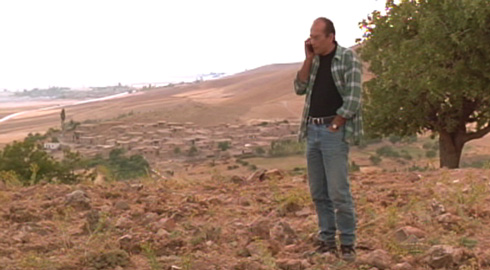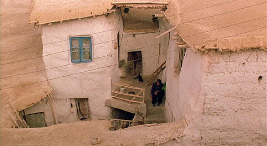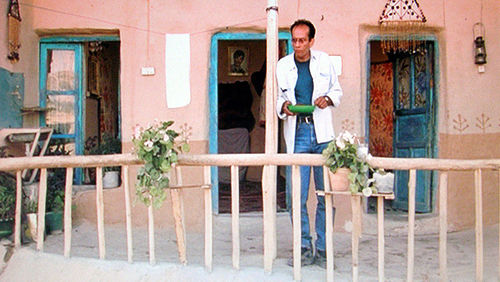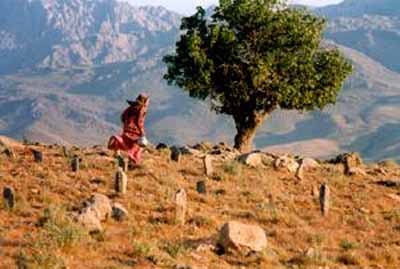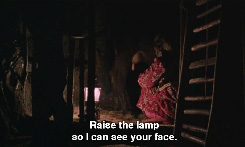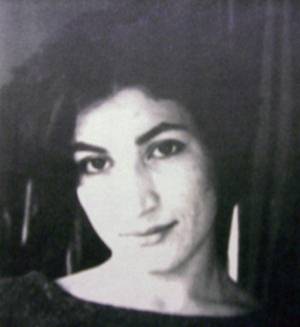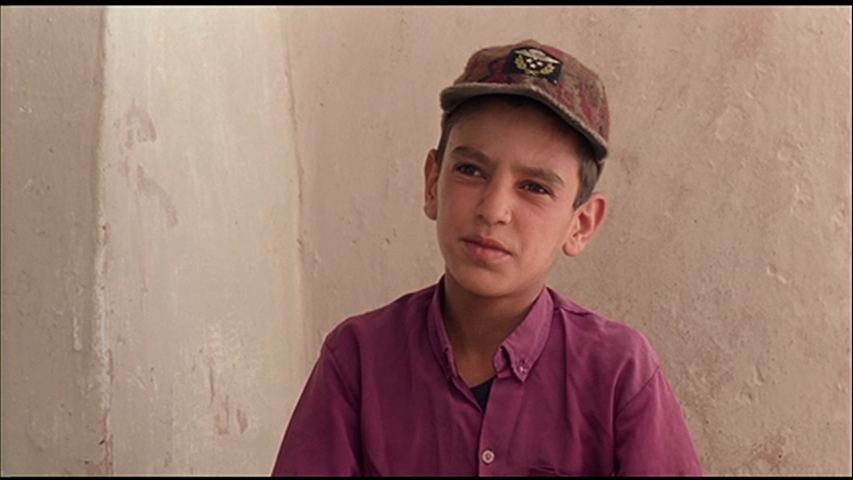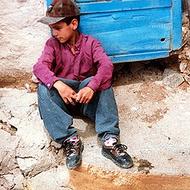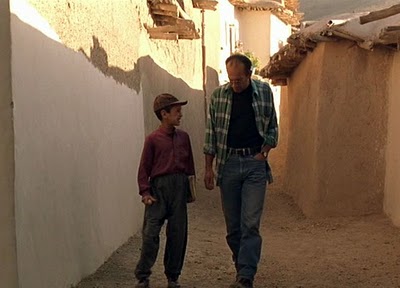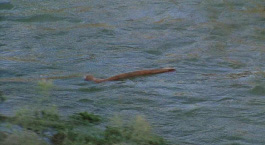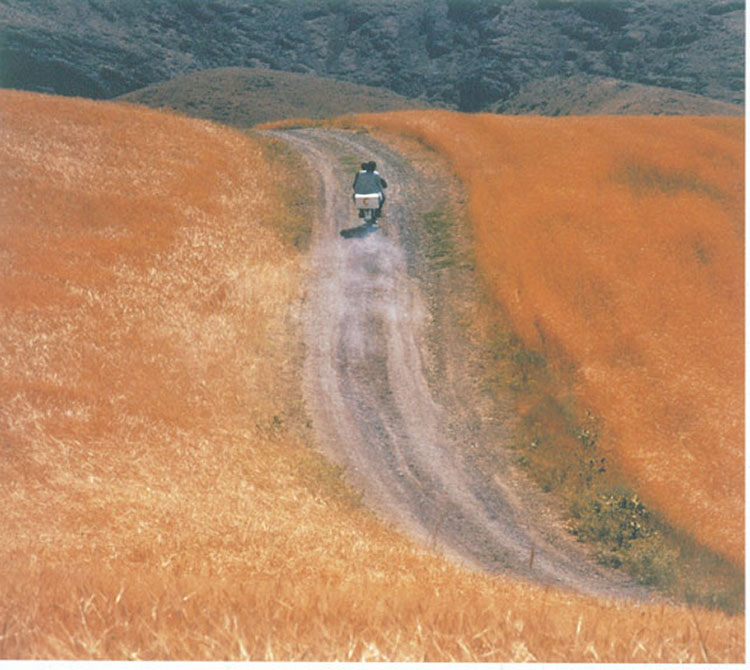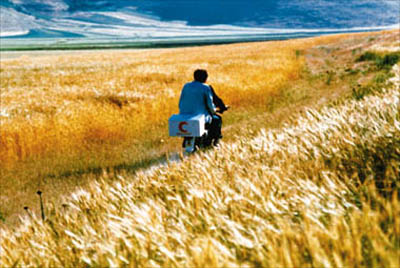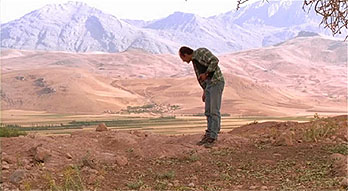This appeared in the December 8, 2000 issue of the Chicago Reader. — J.R.
The Wind Will Carry Us
****
Directed by Abbas Kiarostami
Written by Kiarostami and Mahmoud Ayedin
With Behzad Dourani, Farzad Sohrabi, Shahpour Ghobadi, Masood Mansouri, Masoameh Salimi, Bahman Ghobadi, Noghre Asadi, and Ali Reza Naderi.
Paradoxically, Americans still tend to demonize Iranians at a time when Iranian cinema is becoming almost universally recognized as the most ethical in the world. It’s another sign of how limited our understanding of life outside our borders is — which only makes the varied and comprehensive images of Iranian cinema more precious.
It’s true that censorship has helped shape Iranian cinema, but that censorship has had interesting consequences. Women film characters are required to wear chadors, but ordinary Iranian women don’t wear them indoors — which has led to a good many films being set mainly or exclusively in exteriors and focused on public life and social appearances, including all of Abbas Kiarostami’s features since his 1990 masterpiece Close-up. The pivotal title sequence of his most recent feature, The Wind Will Carry Us (1999), opening at the Music Box this week, is set in a dark cellar — and that has a lot to do with what makes this scene metaphysical and momentous and poetically charged, even though practically nothing of consequence happens there.
This film — one of Kiarostami’s greatest and in many ways his richest to date — has reportedly not yet passed the Iranian censors, though it was screened last year in Tehran at the Fajr film festival. I’ve heard a rumor that the title sequence is the main source of contention. If so, understanding what’s at issue might help us reconfigure our skewed and fragmented image of contemporary Iran.
In this country the popular impression of Iran is still colored by images of terrorists dating from the Carter administration, even though Iran is a country of almost 65 million individuals — more people than in France or the United Kingdom, and a population whose melting-pot diversity might be said to resemble our own. Moreover, 65 percent of Iranians are under the age of 25, and a good many of them are reformist, even radical.
Responsibility for some misimpressions and distortions clearly lies within Iran. It’s notoriously difficult, for instance, to track specific decisions by Iranian film censors and the reasons for them, which often aren’t made public. So I haven’t been able to confirm or disprove the rumor that The Wind Will Carry Us has been held back from domestic release because of its title sequence — though I’m fascinated that when I’ve asked Iranians about the possibility they find it perfectly plausible. It also seems possible that Kiarostami’s reputation in Iran as a star in the West — even though he’s also had enormous influence on other Iranian filmmakers — might play a role in such a decision.
The hero of The Wind Will Carry Us is a man from Tehran named Behzad (Behzad Dourani) who drives with a camera crew of three to a remote Kurdish village clinging to the sides of two mountains. There they secretly wait for an ailing 100-year-old woman named Mrs. Malek to die, apparently planning to film or tape the exotic traditional funeral ceremony they expect to take place afterward, as part of which some women mourners scratch and scar their faces. Behzad spends most of the movie biding his time in the village, circulating a false story (involving buried treasure) about the reason for his presence and chatting with a few locals — mainly a little boy named Farzad (Farzad Sohrabi), the old woman’s grandson, who serves as his (and our) main source of information about the village.
Whenever Behzad’s mobile phone rings he has to drive to the cemetery on top of a hill overlooking the village to pick up his caller’s signal. (The first call he receives is from his family in Tehran, and we discover that by waiting for the old woman’s funeral, he’ll miss a funeral in his own family; all the subsequent calls are from his producer in Tehran — a woman like the producer in Kiarostami’s Through the Olive Trees.) At the same location he periodically chats with Youssef, a young man digging a deep hole for unstated “telecommunications” purposes (most likely an antenna tower). Behzad tells Youssef more than once how lucky he is not to be working under any boss, and after glimpsing the retreating figure of the digger’s 16-year-old fiancee, Zeynab, who brings him tea from time to time, Behzad endeavors to meet her in the village by asking to buy some fresh milk from her family.
In the seven-minute title sequence, occurring roughly halfway through the film, Behzad is directed to a cellar lit only by a hurricane lamp, where Zeynab obligingly milks a cow for him. Over the course of a long take from a stationary camera, Behzad remains offscreen while Zeynab is filmed mainly from behind, though we can see her hands milking the cow. He idly flirts with her and casually remarks, “I’m one of Youssef’s friends — in fact, I’m his boss.” He also speaks to her somewhat condescendingly about Foroogh Farrokhzaad (1935-’67) — a writer of erotic feminist poetry who’s widely regarded as Persian literature’s finest woman poet and Iran’s greatest 20th-century poet. In between his comments and questions, to which she makes minimal responses, he recites one of Farrokhzaad’s poems in full (translation here by David Martin, which differs from that in the film):
in my small night,
what mounting regret!
wind has a rendezvous
with the trees’ leaves
in my small night,
there is terror of desolation
listen! do you hear
the wind of darkness howling?
I watch breathless
-ly and wondrously this alien happiness
I am addicted to my own hopelessness
listen! listen well!
can you hear the darkness
howling? — the dark hell
-wind scything
its way towards us?
in the night now, there is something
passing
the moon is red restless and uneasy
and on this roof — which fears
any moment
— it may cave in —
clouds like crowds of mourners
await to break in rain
ruin
a moment
and then after that, nothing.
behind this window, night shivers
and the earth stands still
behind this window an unknown
something fears for me and you
you who are green from head to toe!
put your hands
— like a burning
memory into my loving hands —
lover’s hands!
entrust your lips — your lips
like a warm sense of being! —
entrust! — your lips to the caresses of my
— loving lips — lover’s lips!
the wind will carry us with it
the wind will carry us with it
It’s important to stress that this poem has never been censored in Iran, and even though Farrokhzaad remains a controversial figure — in part because of scandals involving her volatile love life — she’s so adored that there would surely be a public outcry if any of her poetry were suppressed. (Most Iranians refer to her affectionately as “Foroogh.”) Another scene in the film briefly and quite incidentally shows us a pair of fornicating cows, yet no Iranian I’ve spoken to has suggested that this detail might be worrying the censors. In other words, it appears that they consider the viewer’s imagination more dangerous than anything that’s seen, and for this reason they find the erotic atmosphere in the cellar unacceptably provocative. It’s a scene with echoes in Behzad’s encounters with an older woman who runs a local cafe and some local women he photographs, all of whom seem to see him as an invader and his car and camera as weapons.
My guess is that the cellar scene is provocative mostly because it taps into the sort of emotions and sensations that are stirred by poetry. According to Elaine Sciolino’s recent book Persian Mirrors: The Elusive Face of Iran, “Simply put, poetry for Iranians is religion, a religion as powerful as Islam.” It’s hardly exceptional that Kiarostami, who published a collection of his beautiful landscape photographs in Europe last year, shortly afterward published a collection of his poems in Iran — many of them haikulike images, like sketches for moments in his films.
Literary prose seems to create the same sort of passionate response. I’ve heard that as many as ten William Faulkner novels are available in Persian translation, but an American who wants to read the works of a comparable 20th-century Iranian, Sadegh Hedayat (1903-’51), will have to be content with a single novella, “The Blind Owl.” (You probably won’t be able to find Farrokhzaad’s only collection in English without special ordering it, and trying to find out what’s available from most Persian authors isn’t easy because of the variant spellings of names, including “Forough Farrokhzad” and “Sadiq Hidayat.”) “The Blind Owl” is a lush, decadent, necrophiliac fantasy that makes both Poe and Baudelaire seem tame; it’s the last thing one might expect from a revered work of Iranian fiction, and it suggests that art assumes an ethical and spiritual magnitude in that culture that effectively confounds most of our received notions about Iranian tastes — they’re hardly as prudish as we assume. Ultimately, art is sometimes considered dangerous — dangerous enough to be censored — because it’s valued so highly. (Hedayat was, incidentally, a disciple of Jean-Paul Sartre and one of the first Iranians to translate Franz Kafka.)
In the title sequence of The Wind Will Carry Us absences define presences in numerous ways. In fact, many major characters in the film — including Mrs. Malek, Youssef, and all three members of Behzad’s crew — are never seen. Most of the sequence unfolds in semidarkness, and it isn’t until the very end of it, after Behzad leaves, that we get to see Zeynab’s face in broad daylight, and then only from a distance. (Her refusal to show him her face, even when he asks her to, is obviously a way of resisting his aggressive behavior.) Kiarostami’s reasons for leaving things out probably have little to do with censorship and a great deal to do with the viewer’s imagination — not to mention an understanding of what human presence consists of in film, particularly when microphones play at least as important a role as cameras in the overall design. (Kiarostami spent months working on this film’s sound track, which is every bit as creatively selective — and therefore composed — as the images; he told me he studied Robert Bresson’s films for guidance.) Furthermore, Kiarostami’s insistence on throwing us back on our own resources — refusing to take us into the village houses, for instance, except for the scene in the cellar, where we can barely see anything — means that we have to become navigators of his elliptical spaces along with Behzad. (In one exterior scene, viewed from a balcony, Behzad accidentally drops a green apple to Farzad, who’s on a lower level; it rolls this way and that on a magically unpredictable course — a zigzagging pattern repeated throughout the film, effectively charting the opening shot as well as the last. The recurrence of such patterns in Kiarostami’s work — from the path in Where Is the Friend’s House? to the kicked spray can in Close-up — amounts to a directorial signature.)
The TV antennas that dot the village help us realize that these people are no more beyond the reach of media than the media people are beyond the reach of the village. The key point is that they speak different body languages, occupy different time frames, and utilize power quite differently. For instance, the villagers often deferentially refer to Behzad as “the engineer,” and in some ways Kiarostami seems as amused by their automatic respect for him as he is by Behzad’s equally automatic indifference to most of their concerns.
I began by describing of contemporary Iranian cinema as the most ethical in the world. The particular ethics of The Wind Will Carry Us consist largely of Kiarostami reflecting on his own practice as a “media person” exploiting poor people: Behzad may be the closest thing in Kiarostami’s work to a critical self-portrait, at least since the hero in his highly uncharacteristic 1977 feature Report. The most obvious marker of this autocritique is Behzad’s cruelty when, during a moment of angry frustration, he kicks a turtle onto its back and leaves it stranded, though the turtle manages to right itself as Behzad drives back down the hill. A far more telling, if subtle, moment occurs just before the title sequence, when Behzad asks Farzad to fetch him a bowl to carry the milk he’s about to get from Zeynab, though the boy keeps insisting he’s too busy and wants to get back to his work in the fields. The full ethical resonance of this scene is likely to pass unnoticed by viewers unfamiliar with Kiarostami’s shooting methods — he often works without scripted dialogue, directly interviews his nonprofessional actors himself, and then incorporates their responses into dialogue between his fictional characters. (The line between documentary and fiction in his work is almost always ambiguous.) The following exchange takes place as the camera cuts between the two characters:
Behzad: “Can you answer me frankly?”
Farzad: “Yes.”
Behzad: “Do you think I’m bad?”
Farzad (smiling): “No.”
Behzad: “Are you sure?”
Farzad (assertively): “Yes.”
Behzad: “How can you be sure?”
Farzad (blushing a good deal): “I know…you’re good.”
Behzad (smiling broadly): “Well, since I’m good, can you get me a bowl to carry the milk?”
When I asked Kiarostami if he was the one asking Farzad these questions, he confirmed my suspicion, adding that he felt he had to ask them because he knew Farzad disliked him — and liked Behzad Dourani, the actor playing Behzad. “So that’s why he wasn’t very convincing when he called me a good man,” Kiarostami said with a laugh. No less telling is Zeynab’s circumspection and reticence about responding to Behzad’s teasing and bullying. (A more trivial self-reflexive theme in the film is Behzad’s frequent difficulty locating his invisible crew; Kiarostami has complained in many interviews about the late rising and frequent unavailability of his cinematographer, Mahmoud Kalari, during shooting.)
My point is that Kiarostami is critiquing the whole premise of his filmmaking from an ethical standpoint. (He also gives an ethical reason for wanting to shoot his next feature on digital video — because it will interfere less with the lives of the people he shoots; he’s already used that format to shoot a feature-length documentary about AIDS in Africa, which hasn’t yet been released.) Broadly speaking, he’s implying that there’s no ethical difference between a TV director making a documentary about an old woman’s funeral and a celebrated filmmaker-artist like himself entering a village to make a feature. It’s worth adding that all his features since 1990 — starting with the documentary Homework and continuing with the semidocumentary Close-up and the semifictional Life and Nothing More, Through the Olive Trees, Taste of Cherry, and The Wind Will Carry Us — deal with interactions between relatively empowered figures such as himself (as filmmaker or potential employer) and relatively disempowered working-class people (his potential employees).
Yet Kiarostami doesn’t present Behzad simply as a villain. After a subsequent scene in which Behzad berates Farzad in a particularly demeaning way, he goes out of his way to apologize to the boy. In contrast to his gratuitous cruelty toward the turtle, he later watches the Herculean efforts of a dung beetle pushing its load on the same hilltop with genuine admiration. He refuses to get dirty by attempting to dig out Youssef when he’s buried by a cave-in and nearly suffocates; but he does drive around frantically enlisting other villagers to do it, and he obviously cares about Youssef’s fate. Perhaps the most important thing about Behzad isn’t whether he’s simply good or bad — the subject of his ambiguous conversation with Farzad — but the contrast between the ways he and the locals relate to the world around them.
Part of this movie’s vitality is that it feels as up-to-date as the postelection fracas in Florida — Behzad and his crew waiting for the old woman to die recalls the spin doctors impatiently awaiting recounts and judges’ decisions while telling us what they presume we’re thinking. (Speak to any stranger about what’s going on and you’re likely to find yourself in sympathetic accord, regardless of how each of you voted; but turn on the TV and you’ll see angry partisan squabbling and name-calling and endless accounts of our alleged impatience.) The faulty technology of the city slicker — Behzad’s recalcitrant mobile phone — also calls to mind our flawed balloting machinery. Both induce a frenetic, contorted, slapstick dance in us as we try to overcome our helplessness in the face of the machines that rule our lives.
By concentrating on the death of a century-old woman in the year 1999, Kiarostami also seems to be making some sort of millennial statement — something that possibly means less inside Iran, which has a different calendar. By comically divvying up his world into media “experts” and peasants — moguls with cellular phones and ordinary working people — he’s raising the issue of who owns this world and who deserves to.
Is there any more pressing and relevant global issue at the moment? This is the film’s major theme, though I hasten to add it isn’t the only one. One of the major themes of Taste of Cherry, Kiarostami’s previous feature — mortality in general and the process of being buried in particular — returns here as a secondary theme, along with the equally relevant motif of birth. (A human thighbone, found in Youssef’s hole and carried around for a spell by Behzad, functions as a highly suggestive prop.) Uniting all of these themes is poetry — lines from Rumi and The Rubaiyat of Omar Khayyam as well as Foroogh Farrokhzaad — which sometimes appears to be the biggest thing the characters have in common.
With the possible exception of a doctor on a motorbike — who exudes warm and familiar folk wisdom with a little more facility than I would have liked and reminds me a bit too much of the Turkish taxidermist in Taste of Cherry — Kiarostami’s reading of what separates the media savants from the farming people generally avoids sentimentality and cant. One reason for this that I’ve already suggested is that Behzad remains a troublingly equivocal figure, a hero we can neither accept nor reject wholeheartedly. The very fact that we’re watching a film places us in some respects on his side and against the villagers, whether we want to be there or not, so Kiarostami works overtime attempting to rectify that balance and show us things Behzad is unlikely to notice.
Perhaps the most impressive of these things is the village itself, with all its intricate interweavings, ambiguities, and declivities — it’s an architectural marvel both as a subject and a backdrop. The Wind Will Carry Us offers an intricately constructed spatial world that’s as breathtakingly beautiful, as various, and as cosmically evocative as a Brueghel landscape — a world teeming with diverse kinds of life and activity — and it teases us whenever we want to get to know this world better, seducing and evading us at the same time.

